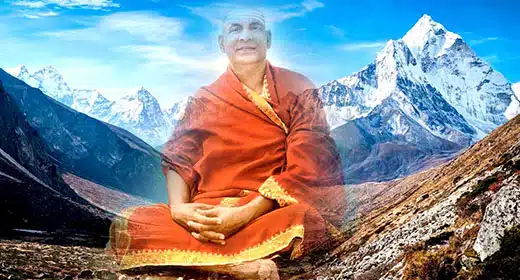by Shunryu Suzuki: Once a time of one thousand or two thousand is not so long time in comparison to our idea of time. It is just, you know, one thousand or hundred years of time, maybe, one month or less than one month.
 We came to the point where we must study Buddhism from various direction, and here we are started to study Buddhist way from various angle. And this is not so easy task. I think that is why we must have Buddha or Dōgen-zenji, because each one of our effort—by each one of our effort cannot be satisfy.
We came to the point where we must study Buddhism from various direction, and here we are started to study Buddhist way from various angle. And this is not so easy task. I think that is why we must have Buddha or Dōgen-zenji, because each one of our effort—by each one of our effort cannot be satisfy.
Our purpose of studying Buddhism—in Japan this kind of study started, maybe, from Meiji period—early part of Meiji period. Of course there were some exceptionally great teachers before Meiji period. But after Meiji period, we started to study Buddhism, applying Western way of study. Very strong: more scientific way of study, like you study anthropology or sociology. So Buddhism culture [was] analyzed from various angle and criticized from various angle: whether Buddhism is—has been helping human being or not. Now in this way, after Meiji period, we started to study Buddhism very sincerely and very objectively and very critically.
So right now we haven’t, you know—even [though] we belong to same school of Buddhism—the each one has his own opinion or his own, you know, understanding of Buddhism. So I think it is a time when we get together and study Buddhism from various angle. And we should not be discouraged by knowing various teachers’ way is not the same. It cannot be same. And one teacher—even one teacher—changing his way, always, because he find some reason why he should change his way. If there is some, you know, decisive reason why he should change his way, he should, you know. If he is a Buddhist, he should change because we should—we don’t stick to our previous understanding, moment after moment.
We continue our practice and our understa- [partial word]—our study. I heard—I hear various informations from Japan, you know—what kind of practice is going at Eihei-ji or some other monasteries. The more I hear various different information from various source, we feel, you know, the need of discussing—a need of real, you know, sincere study—a need of—you know, affirming, you know, our belief.
Something which we have been doing in Japan may be difficult for you to accept. Tonight I want to concentrate—I want to be concentrated on some point which, maybe, which you may find it difficult to accept [laughs]. Something—you know, this is the point I want to talk tonight is the charac- [partial word]—one of the characteristic of Buddhist thought and one of the—and which, you know, you do not have in your culture. If I am right—you know I haven’t study Western culture so much—so I can’t say definitely, but I find some difficulties for Western students to—when you want to accept our Buddhist teaching. For an instance, you know, freedom, you mean is not the freedom we Buddhist mean.
Buddha, you know, rejected asceticism. But still, you know, Buddhist way is—there is ascetic element in it. The love, you mean is not the same as when we say “love.” Desire, you know, we mean, is not the same when you say “desire.” The we, know—almost all the time we say—we do not say “good desire” [laughs]. We say—we Buddhist say “evil desires.” Evil is, you know, always follow to desire.
For an instance, you—you choose—you like some bright colors, you know, but Buddhist use subdued color [laughs]. This is very—this is one of the characteristic of Buddhism. Blue, or, you know, yellow, red, or white, black: those are, you know, those are not subdued color. The subdued color is the mixed color. The Bu- [partial word]—the material we use for robe is not the material people may like. We shave our head, you know, wear okesa. Those, you know—this is—why we shave our head is to be free from the desire to put some ornament, you know, on our head—on our head, you know.
This kind of negative and opposite—negative tendency or element in our teaching will be very difficult point. But on the other hand, you know, when you start zazen practice, or when you start some particular—some practice—you become more—you tend to be more ascetic than are [?] people. You want to observe—you want to be strict vegetarian, you know. And e- [partial word]—when you start something, you go on and on and on, but the way you push your—you carry on your practice is more positive—not negative way—positive way. I think this is the difference between the—there is—some slight, you know, flavor is different. Nuance is different.
The negative attitude we have is after realizing what we are doing in our everyday life—what kind of nature we human being has. And to avoid this kind of fault, Buddhist, you know, try to—try to make our human tendency—bad tendency weaker, because we know this kind of tendency will create many problem in our society.
So we try to control or restrict, even, our activity. Instead of working fast, we try to work slowly, step-by-step, moderating our tendency. This kind of thing—tendency or element—may be very hard for you to understand.
The—why old people or people in old tradition [are] interested in Buddhism is people who live in the countries where there is old tradition, they understand good side of the culture and bad side of the culture. So they, you know, are not so interested in a kind of achievement. They achieved in their history. So they reflect [on?] their culture more, and after reflecting on their culture—or after getting tired of their own culture, they start to became—become interested in Buddhism which is negative. Here there is some reason, you know, why Western, you know, young people become interested in Buddhism or Zen.
So young generation, you know, in America became tired of, you know, materialistic culture, and they start to realize what will become of America if we, you know, push this kind of effort. So maybe this is wrong. We started to realize something—something missing in our culture. So that is why Buddhism is now developing in this country.
But still there is, I feel, slight, you know, difference, and we Buddhists are not so interested in success in life or achievement of some special thing or propagating our way. Before we try to propagate our way, we try to accept the teaching completely. Unless—until we have strong confidence in our teaching, we do not try to, you know, push our teaching to someone else. And we understand that to have good understanding or to accept teaching as his own is already the best way to propagate our way.
To study Buddhism is to teach Buddhism. And to know ourselves is to know others. This is, you know, our way. So instead of working towards outside, we work towards inside. And this is rather hard, you know. I think you are trying very hard to work towards inside. But still, there is slight difference, you know. It must be so, you know. It is quite natural for you to be so but—but when we, you know, make one step further from this stage in our study of Buddhism, we will—we must have—and it is natural to have this kind of difficulties. If we are not patient enough, you know, to get through this kind of difficulty—unless we make more effort on this point, our effort will not make much sense in its true sense.
So now what we want is—what we should do here is to develop our study from your bottom of your heart. That is the most important point. You must be very faithful to yourself. And even though you cannot accept a teaching of Buddhism, you should try best effort to understand it and accept it. That does not mean, you know, I’m forcing Buddhism to you. But from your side, you should make more effort and—to accept or to think over and over what Buddha is suggesting for us.
And next point, maybe, we should not, you know, try to be successful, you know. We should be concentrated in our effort rather than work, you know, towards people. Of course, we should—we should not reject people, but we should not invite many people unnecessarily. So once someone come, we should try best effort to show our way, if possible, not by mouth, but by our actual practice.
And we should, I think, as already we started, we must start a kind of study—mutual kind of study, or more wider study from various viewpoint. For an instance, inviting Japanese priest here and—or study—go to Japan and study Japanese Buddhism, whether it is good or bad. If it is bad, we should know why it is so bad. Bad thing may be some medicine for us.
I don’t think, you know, Buddhism in Japan is so healthy now. I must acknowledge [laughs] this point. I am sorry, but [laughs]—I am sorry for Japanese Buddhism, but I have to acknowledge it—accept it. But it does not mean there is no need to study Japanese Buddhism. Japanese Buddhism is still alive in some way. And some people started very sincere study, and we see the result of their study in magazine or in various books they publish. They found out many things which was not came to our knowledge yet. So the study is going, anyway. But even though they make best effort in their study that will not be—that will not—never be perfect. So I think American people also start this kind of sincere study. And from various angle, if we study Buddhism, will come to the good understanding of Buddhism.
The negative attitude in Buddhism arised [arose] from deep insight—insight of our human nature. Why we study Buddhism is because we find some weak point in our human—human nature. Without—if you accept various desires you have, you know, or instinct you have, there is not much reason why you have to practice, for an instance, Zen. Because you, you know, you know the good point and bad point of thinking mind or emotional activity. We practice zazen because that is the only way to go beyond thinking mind—emotional activity.
Since I have been explaining negative, you know, negative practice in positive way [laughs], so it is difficult for me now to explain it negative way [laughs]. But actually, what is written in the scripture is negative side of Buddhism almost all the time, you know. Their description is
concentrated on negative side of Buddhism. But when you realize why they take negative viewpoint, then we can take a positive practice to make best use of our desires.
Visitor: Excuse me. Excuse me. May I ask a question? Did anyone park a station wagon at the corner of Laguna and Rose? [4-6 words unclear.]
Zazen practice is became attracting people, you know, because of its positive side of attaining enlightenment, you know, or improving your state of mind: to have some, you know, power—physical or spiritual power to do things as you may want to do—or to solve your everyday problem, or to improve your mental activity, or to make your—make yourself physically strong. But actually in—especially in shikantaka Sōtō practice, is very negative.
[Laughing.] You may be very much discouraged to practice Sōtō shikantaza. But it is so, you know. We try not [to] think in our practice. We try not [to] see things, you know. Or we try not [to] hear things. But sound—if sound come, we—naturally we will hear it. But we shouldn’t be disturbed by it. We shouldn’t be curious about the sound—what it is. How we do it, you know, is to have right posture. To have—”right posture” means, you know, if—I—if we want—I want to explain what is right posture, you know, it should not be like this, or it should not be like that. Or it you are not like this or like that [probably gesturing, laughs]. If you are not like this or like that, this is right posture, we say, you know [laughs].
So from the beginning to end, our practice is negative [laughs]. There is no other way to explain it, you know, well—so well in positive way. Don’t, you know, be bothered by it—don’t be bothered by it. Don’t see it, or don’t—[interrupted by coughing]. So how you don’t think is, you know, just to be like this [laughs]. That—just to be like mountain, according to Dōgen-zenji,gotsugochi.[1] When you are like this [probably gestures], you know, this posture which is not, you know, this way or that way will—practice—various practice—that posture will work on various problems you will have.
So if the sound—even [if] the sound come—if you are not disturbed by it, there is real practice. And we say this is not something you can attain by practice. It is something which you have originally when you are just you—when you are not something more than that.
So we have, you know, very difficult time to convince or to explain ourshikantaza. If—we want to explain it, so we rather concentrated on practice. Actually, to practice our way is the only way to understand what is, you know—what Buddha meant by not being so and not being that: just to be like that or to see things as it is.
So even though we sh- [partial word]—we must study Buddhism from various angle, but we should [not?] neglect [?] our practice, you know, which is only way to—to understand what he meant, you know—what Buddha meant by his sermon. The purpose of our practice is not to attain anything or to—to make you a Zen student. Purpose of practice is just to be yourself, you know, nothing more than that. And by experience, various teachers and patriarchs found out this is the best way, you know, to see—to encounter Buddha, you know. Only when we practice zazen and when we have complete practice, we could—we can understand which is difficult to understand in—by our study, through scriptures or through sermon.
And when you understand what Buddha meant through practice, you will not be attached to Buddha’s sermon or Rinzai way or Sōtō way. There is no Rinzai way or Sōtō way in shikantaza. Maybe to say “shikantaza” is already wrong. Although we have this kind of zeal in our practice, but it does not mean to stick to something. To get free from attachment, or to get free from teaching, we practice zazen. So negative way of expression or positive way of expression doesn’t matter. Whichever it is, we can understand what he meant. [Sentence finished. Tape turned over.
… be always negative. We do not deny that we exist here, eating something, doing something, thinking something, feeling something. Just to feel—just to think properly, we actually practice zazen. So if one thing happen, that is the whole picture of Buddhism. If some—another thing happen, that is whole picture of the Buddhism. So there is, you know, no need to stick to some particular thing. Positive or a negative is on your side, not Buddhist side.
So the practice we have is not just negative practice. It is the way to jump into the reality, or jump into the actual reality we are [in] right now, without any hesitation of thinking about it, or choosing the way, without concerning negative or positive. Just do it, you know.
Maybe that will be the most positive way. And at the same time, it is the most negative way because you stop everything. That is very negative. But at the same time [laughs], that is the most positive way, you know. From this viewpoint, we put stress on our practice so that we can study our way from various directions without any confusion.
So before you discuss, you know, about our way of putting our teaching in word, maybe better to have actual practice and think what it is, actually, and see what it is—what does it mean.
Thank you very much.









































